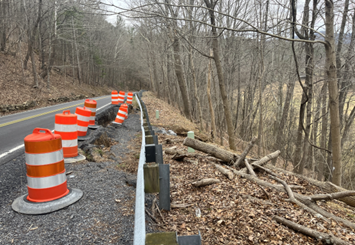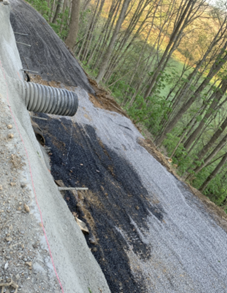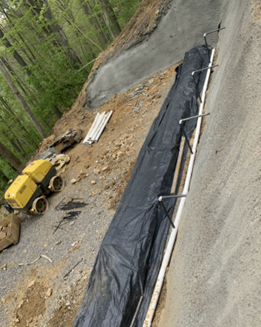
Virginia State Route 159 in Alleghany County is a well-traveled corridor connecting Cliftondale Park to the West Virginia state line. Locals frequently use this roadway to access other parts of the region for travel and recreation. The route plays an important role in supporting the vitality of the community and regional economy, serving as an alternative route when larger highways experience closures.
In spring 2023, under an existing on-call landslide repair contract with the Virginia Department of Transportation (VDOT), GeoStabilization International was called to assess an active slope failure along a 100-foot section of Route 159. The area showed visible signs of distress, including shoulder loss of up to 2 feet, surface cracking, and ongoing settlement. These conditions were compounded by weak native soils, vegetation buildup, groundwater seepage, and a culvert that bisected the slope, requiring careful management throughout construction.
Sustainable design approach
Because surcharge loads could worsen the slope failure, the team did not consider conventional repair methods such as backfilling or excavation. Instead, GeoStabilization developed a sustainable hybrid solution tailored to the site’s geotechnical and environmental conditions.
The team installed soil nail shotcrete walls at the ends of the site (Stations 0+00 to 0+13 and 0+85 to 1+00) to provide localized stabilization. Between these, a 72-foot-long, 12-foot-high Geosynthetically Confined Soil (GCS) wall was constructed using compacted granular fill and closely spaced layers of geotextile. The wall was finished with split-faced concrete masonry unit (CMU) blocks, providing both durability and aesthetic compatibility with the nearby infrastructure.
Initially developed for bridge abutments by FHWA (also referred to as Geosynthetically Reinforced Soil or GRS), GCS walls utilize geotextile at every lift (typically 8 to 9 inches) to achieve superior composite behavior. A key advantage of this system over mechanically stabilized earth (MSE) walls is its shallower embedment. While an MSE wall typically requires 70% of the wall height as embedment, a GCS wall needs only 40% to 50%, which is critical for preserving the existing roadway footprint and reducing excavation/backfill requirements.

Drainage and subsurface water control
Effective water management was essential to the project. A single row of horizontal drains, drilled up to 20 feet into the slope, intercepted subsurface water and redirected it away from the failure plane. VDOT installed a temporary pipe within the existing culvert to maintain surface drainage during construction, and riprap was placed along the bench beneath the wall to prevent erosion.
Wall installation
The sequence began with excavation and slope preparation, followed by the installation of 69 self-drilling hollow-bar soil nails (30 feet in length) and the application of six inches of reinforced shotcrete over approximately 1,100 square feet. The team installed three rows of soil nails up to 20 feet long, along with a shotcrete face.
A total of 74 hollow-bar micropiles and a reinforced micropile cap were installed to support the GCS wall structure. The wall itself was built in eight-inch lifts using compacted #57 stone provided by VDOT, confined between layers of geotextile. In total, crews placed approximately 360 cubic yards (510 tons) of stone. The wall’s split-faced block provided structural integrity and visual consistency with the surrounding infrastructure.

Construction access and sequencing
A ramp was created on one end of the construction site to stage equipment and move materials efficiently while working under a single lane closure with mobile red-light traffic control. This minimized traffic disruption while maintaining safety. The work was completed within an 18-day window using 10-hour workdays.
Mitigating challenges
Throughout the construction process, the GeoStabilization team addressed a variety of site-specific challenges, including traffic flow, drainage management and integrating the culvert into the wall system. VDOT’s use of temporary drainage solutions and erosion protection limited further damage to the outside slope during construction.
Safety first
Throughout the project, the GeoStabilization team was committed to safety on the jobsite. To mitigate risks associated with the challenging work environment, the team implemented comprehensive safety protocols that exceeded industry standards. Specialized training and daily safety briefings were conducted to identify potential hazards or concerns and to reinforce mitigation strategies, while regular safety audits monitored compliance with all jobsite protocols.

Project outcome
The hybrid stabilization system, which combined soil nails, shotcrete, micropiles and GCS technology, delivered a resilient and cost-effective solution with a 75-year design life. The completed project restored safe travel conditions along Route 159 while minimizing environmental impacts and preserving the surrounding landscape. Today, the community once again enjoys safe and reliable access to this important roadway.
 TEXTILES.ORG
TEXTILES.ORG


